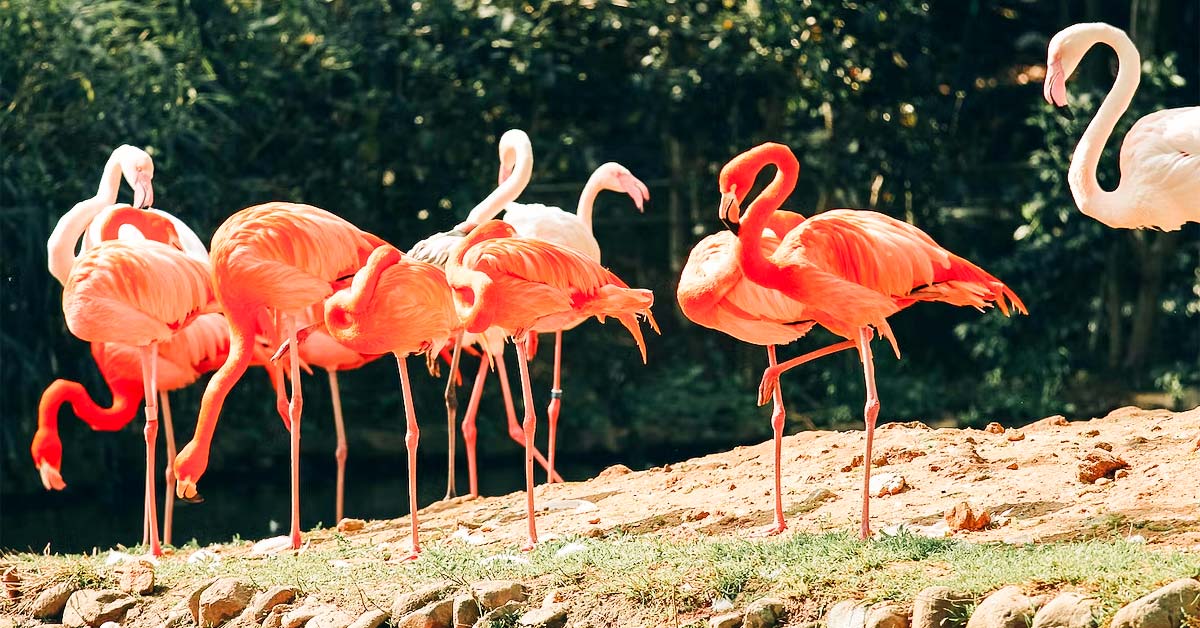Many birds with long legs are intimidating. Looking at these long-legged creatures striding, flying, or waddling in the water can be mesmerizing.
But what makes these birds unique?
Are the long legs exclusive only to waterfowl (or birds that live near water)?
Are the legs as strong as they look?
This post should hopefully clarify a few things about long-legged birds and teach some interesting trivia about them.
What Makes Birds with Long Legs Unique
Birds with long legs have an advantage to smaller -legged birds because they can:
- reach higher plants/trees in search of insects
- wade in water more easily and look for food underwater
- run faster with bigger strides, which in turn keep them safe from predators and allow them to catch food better.
The downside to birds having long legs is that they are often massive in size as well. Meaning, hiding would prove more difficult.
8 Cool Birds with Long Legs
Birds in the family Ardeidae (herons, egrets, and bitterns) are some of the more popular birds with long legs. But they’re not the only ones.
Check out these 9 long-legged birds that I find the most interesting:
1. Cattle Egret (Bubulcus ibis)
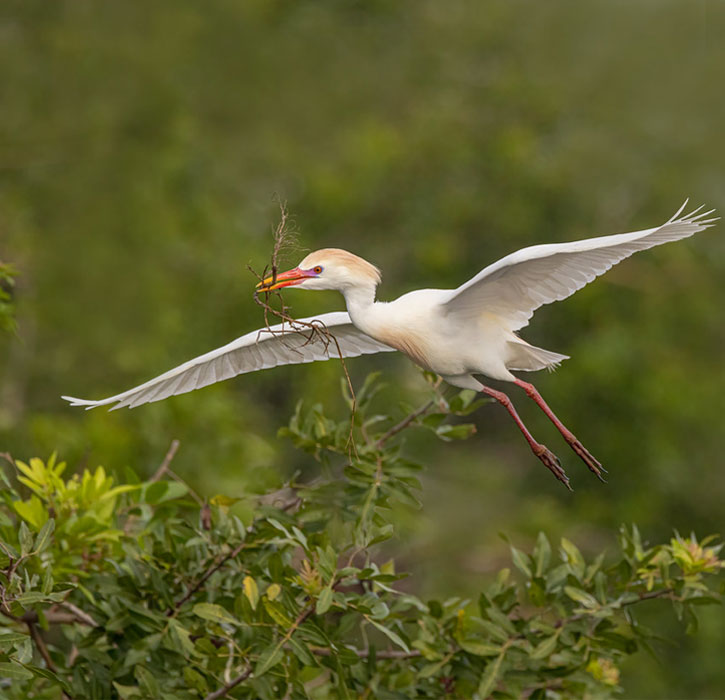
- Length: 18 to 22 inches
- Weight: 9.5-18.1 ounces
- Wingspan: 36 inches
Believed to have originated in central Africa, the Cattle Egret was imported and spread in the 19th century to countries in Asia, Australia, Europe, South America and North America.
The Cattle Egret is just one example from the Egret family. These birds use their long legs to observe their prey and pounce at the right time.
Where is Cattle Egret found in the US: They are found in the southeast parts of America, usually in meadows,, swamps, pastures, pastures, and fields. As their name suggest, these egrets are associate with cattle.
What do Cattle Egrets look like: Most egrets have long legs, but the Cattle Egret is the only egret with a white body. Its bill and legs are yellow-colored.
What do Cattle Egrets eat: These egrets feed mostly on water insects like dragonflies and other small animals. Sometimes, they would prey on snakes and smaller amphibians.
2. Roseate Spoonbill (Platalea ajaja)
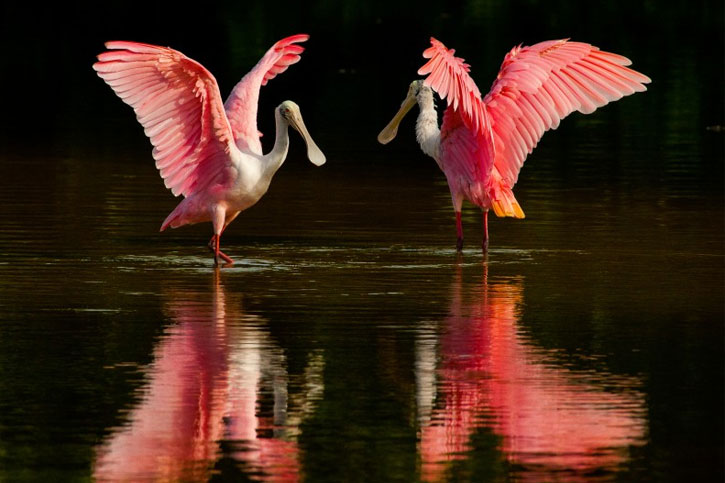
- Length: 28 to 32 inches
- Weight: 42 to 64 ounces
- Wingspan: 50 inches
The Roseate Spoonbill is a large wading bird that uses their long legs to wade in the water when hunting. As social creatures, these birds love to hunt in small flocks of fellow roseate spoonbills and other wading birds like ibises, egrets and herons.
When they fly, Roseate Spoonbills can be quite a sight because of their size and slow-moving flight.
Where is Roseate Spoonbill found in the US: In America, you can find these gorgeous, pink-tinged spoonbills in Texas, southwest Louisiana, and Florida coasts.
What do Roseate Spoonbills look like: These big spoonbills are often mistaken as flamingos because of their white, pink and orange colors, but you’ll know at closer look that the Roseate Spoonbill look different. First because of their orange tail, white neck and their flat, wide and rounded tip to the bill.
What do Roseate Spoonbills eat: Roseate Spoonbills use their bills to scoop prey from shallow water. Their diets include shrimp, crabs, crayfish, minnows, small crustaceans, insects, and small fish.
3. Black-necked Stilt (Himantopus mexicanus)
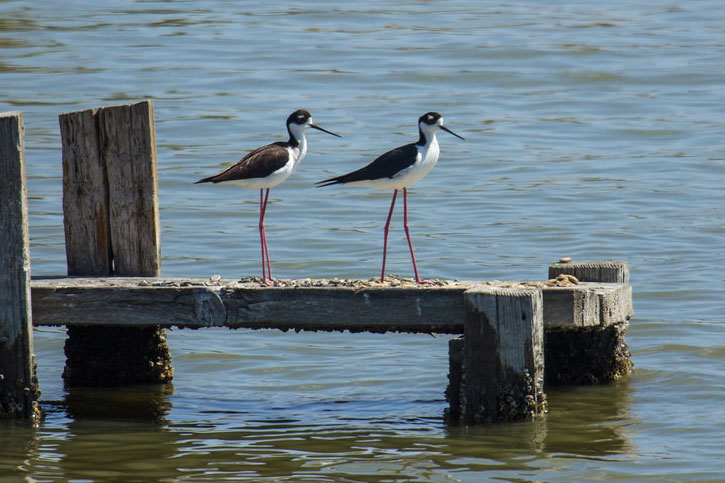
- Length: 13 to 17 inches
- Weight: 5.3 to 6.2 ounces
- Wingspan: 27 inches
Black-necked stilts are probably the smallest birds with long legs on this list, but they have the longest lifespan at over 20 years.
Black-necked stilts have the perfect long legs that they use in wading shallow waters in search for food. They don’t need to swim or fly to catch their prey, but use their long legs to find their target and sharp claws to grab them.
Where are Black-necked stilts found in the US: These shorebirds are native to North America and can be seen mostly in coastlines and wetlands all over the country. They prefer to live in shallow lagoons, ponds, rice fields, saltmarshes, freshwater swamps and other similar wetlands.
What do Black-necked stilts look like: As their name suggests, these white birds have black necks, long bills, and distinctively red-colored long legs.
What do Black-necked stilts eat: Black-necked stilts eat snails, shrimps, beetles, other small insects and plants underwater.
4. Great Blue Heron (Ardea herodias)
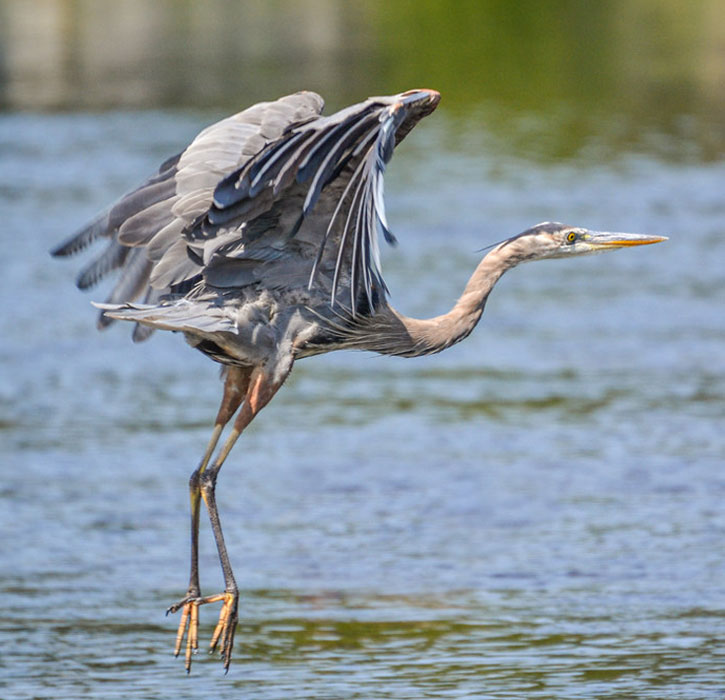
- Length: 3.8 to 54 inches
- Weight: up to 88 ounces
- Wingspan: 79 inches (that’s a whopping six feet!)
The Great Blue Herons are the largest herons in North America. They love hanging out at fish hatcheries, which is why they’ve always had a pest-like reputation. Fish farmers originally hated them congregating there (some still do today), but research has suggested that these long-legged birds actually help these farmers by eating sick fish that would have contaminated the entire hatchery.
Great Blue Herons use their long legs to watch prey over wider areas and at a higher vantage point. They use their long necks to reach prey even at a distance.
Where are Great Blue Herons found in the US: Great Blue Herons live all over the country, often in saltwater and freshwater habitats, swamps, agricultural fields, grasslands, and similar environments.
What do Great Blue Herons look like: Despite their name, Great Blue Herons aren’t actually blue. They’re more on the bluish-gray color with striped white, gray and black underside.
What do Great Blue Herons eat: These birds mostly eat small fish found in their aquatic environment, but their diets also include reptiles, insects, amphibians and small mammals.
5. Scarlet Ibis (Eudocimus rubber)
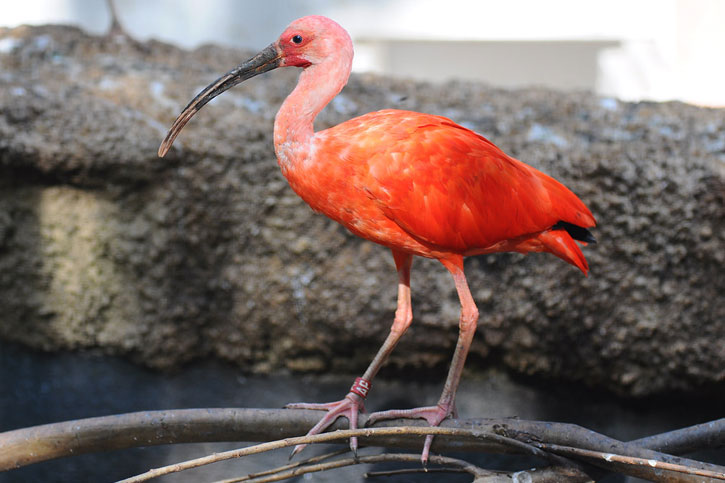
- Length: 22 to 30 inches
- Weight: 5 to 7 ounces
- Wingspan: 12 inches
The Scarlet Ibis has protected status around the world. As you can imagine, these birds have been hunted for their stunning pink-to-red plumage.
Like most birds with long legs, Scarlet Ibises use their legs to wade in swamps and mangroves, hunting prey better even in muddy environments.
Where are Scarlet Ibises found in the US: Scarlet Ibises are found in lagoons estuaries, mangrove swamps and tropical wetlands throughout Brazil, Venezuela and the Caribbean. These gorgeous birds have not been seen in the wild in America, but you can visit them in bird sanctuaries and zoos particularly in Florida.
What do Scarlet Ibises look like: Scarlet Ibises have a striking orangey red to pink plumage with black wingtips. What I love most about this bird is that they normally have pink bills, which turns into black bills throughout the breeding season.
What do Scarlet Ibises eat: The Scarlet Ibis eats a variety of things, including small fish, frogs, mollusks, crabs, and other crustaceans found in their habitats. They also eat worms and insects, especially if they live in the aquarium.
6. Sandhill Crane (Grus canadensis)
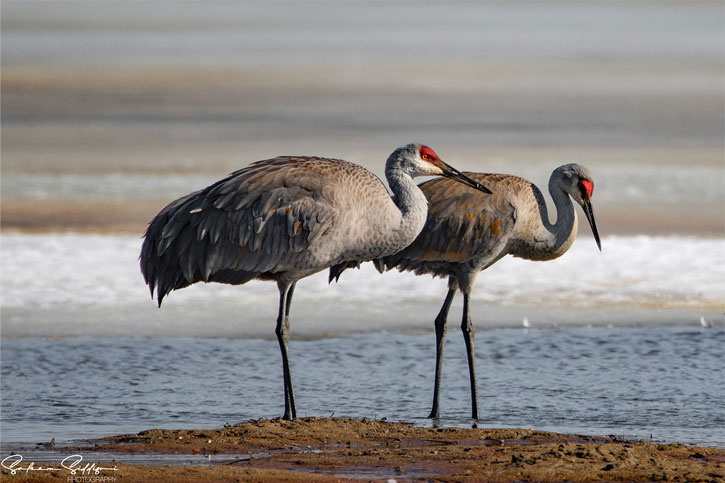
- Length: 42 to 46 inches
- Weight: 113 to 190 ounces
- Wingspan: 80 inches
The Sandhill Crane is usually mistaken for the more-popular Great Blue Heron due to the blue-tinged plumage. However, as you look closer, you’ll see that this bird’s neck is more extended (instead of the heron’s folded necks).
Sandhill Cranes are renowned for their sleek, long legs that look much longer and thinner in comparison to their build.
Where is Sandhill Crane found in the US: Sandhill Cranes live in the southern part of the United States during the start of the year. During late winter months, they tend to move towards California, Florida, Texas and other warmer southern states.
What do Sandhill Cranes look like: Sandhill Cranes are easy to identify thanks to the red patch on its head and white patch on their cheeks.
What do Sandhill Cranes eat: These birds are considered opportunistic foragers, eating any food they find within their surroundings. They feed on small animals, insects, grains, seeds and other kinds of vegetation nearby.
7. Secretary Bird (Sagittarius serpentarius)
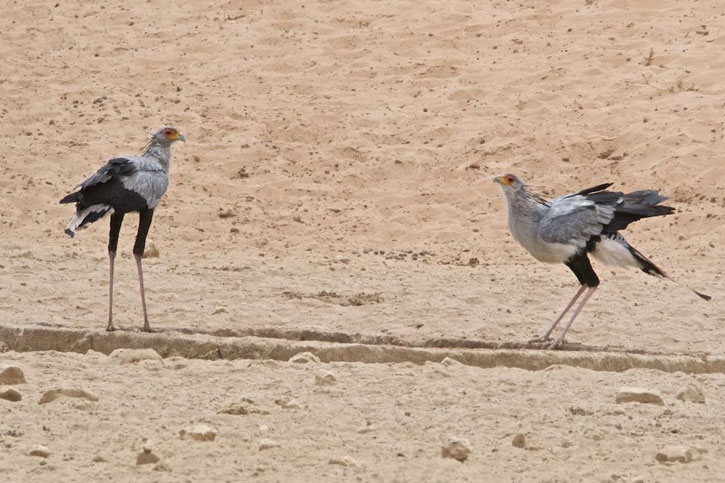
- Length: 4 to 5 inches
- Weight: 132 to 151 ounces
- Wingspan: 6 to 7 inches
Secretary birds have vulnerable status, but with the right conditions, they have a lifespan of up to 15 years.
Secretary birds may not be found in the wild of North America, but they’re such unique characters. First, they’re called devil’s horse for their speed (they can travel up to 30 kilometers a day) and their preference for hanging out on the ground (yes, even if they can fly).
Where are Secretary Birds found in the US: These birds of prey are native to Africa, particularly in the south of the Sahara Desert, Somalia, Senegal and South Africa. In America, they can be found in zoos like San Diego Zoo.
What do Secretary Birds look like: Secretary birds have a dramatic black crest of feathers on the back of their heads and orange, yellow or red faces. All over their bodies, they have white and gray plumage with two long tail feathers with a distinctive black tips.
What do Secretary Birds eat: These birds eat a wide variety of foods, from mice, hares, frogs, lizards, hedgehogs, grasshoppers, small mammals, and invertebrates like crabs, millipedes, scorpions, etc. Secretary birds also prey on smaller birds and eat their eggs as well.
8. American Flamingo (Phoenicopterus ruber)
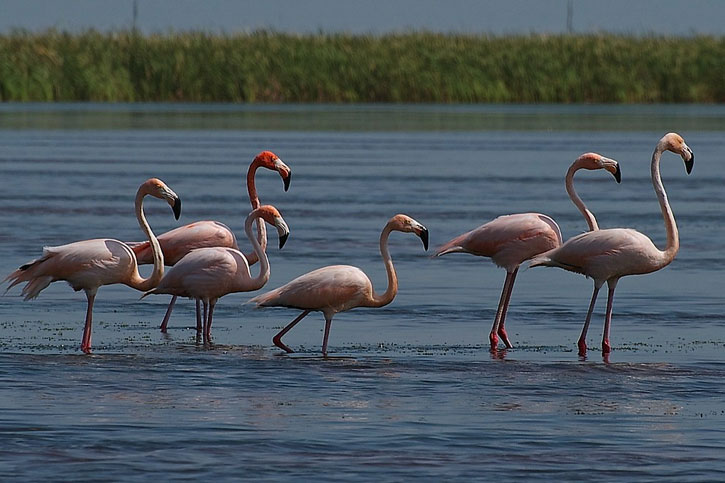
- Length: 45 to 60 inches
- Weight: 3.5 kilograms
- Wingspan: 50 inches
The American Flamingo is a large wading bird that live in large colonies, which contain up to 24,000 individuals. Hunting these beautiful creatures are illegal in most countries, which fortunately has helped preserve their species in many parts of the world.
Like other birds with long legs, American Flamingos use theirs for hunting food. Their long pink legs are complimented with webbed feet, which they use to trample on mud and force insects and small animals underground/underwater to resurface.
Where are American Flamingos found in the US: American Flamingo, despite its name, is found mostly throughout the Caribbean, particularly in estuaries, saltwater, brackish water and alkaline lakes. They breed in countries like the Bahamas, Cuba, Venezuela, Mexico and the British Virgin Islands. If you wish to find them in the US, your best bet is to visit either Florida or Texas. You can also view these stunning creatures at San Diego zoos.
What do American Flamingos look like: These giant birds have pink feathers, distinctively long necks, black-tipped wings, and long pink legs. They also have a large hooked bill with a curved-down black tip.
What do American Flamingos eat: Considered a filter feeder, flamingos forage for small fishes, mollusks, blue-green and red algae, worms, and other insects found in their aquatic habitats. Flamingos also love eating small crustaceans, which contain the carotenoid pigments responsible for their pink-tinged feathers.
Other Cool-Looking Birds
We’re blessed with many cool-looking birds in the country.
From the woodpeckers of Virginia, to the adorable native birds of Kauai Hawaii and the owls of Utah, birdwatching doesn’t have to be exclusive to typical birding spots like Yosemite (Although here’s my guide on all the birds you can find at Yosemite).
If you do a little digging, there’s a good chance your state is home to several cool-looking birds.
My favorite are probably the world’s most purple birds and these funny-looking small birds with long beaks.
